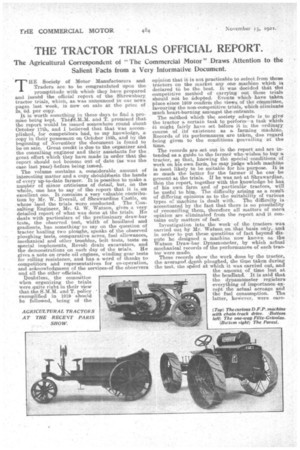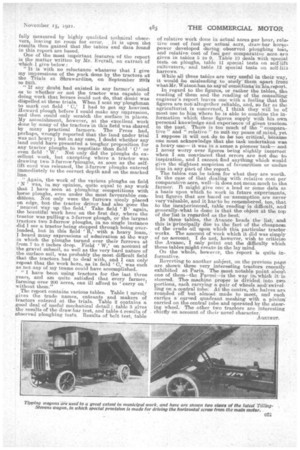THE TRACTOR TRIALS OFFICIAL REPORT.
Page 30

Page 31

If you've noticed an error in this article please click here to report it so we can fix it.
The Agricultural Correspondent of "The Commercial Motor" Draws Attention to the Salient Facts from a Very Informative Document.
T•HE Society of Motor Manufacturers and Traders are to be congratulated upon the) promptitude with which they have prepared and. issued the official report of the Shrewsbury tractor trials, which, as was announced in our news pages last week, is now on sale at the price of 2s. 6d. per copy.
It is worth something in these days to find a promise being kept. Thefd.M.M. and T. promised that. the report would be issued somewhere round about October 17th, and I believed that that was accom.plished, for competitors hid, to my knowledge, a copy in their possession on October 18th, and by the beginning of Noveniber the document is found to be on sale. Great credit is due to the organizer and the consulting engineer and their assistants for the great effort which they have made in order that the report should not become out of date (as was the ease last year) before being issued.
The volume contains a considerable amount of interesting matter and a copy sheuldshesin the hands of every up-to-date farmer. It is loossibie to make a number of minor criticisms of detail, but, on thei whole, one has to say of the report that it is an excellent one. It contains a very valuable contribution by Mr. W. Everall, of Shrawardine Castle, on whose land the trials were conducted. The Consulting Engineer, Mr. G. W. Watson, gives a very detailed report of what was done at the trials. He deals with particulars of the preliminary draw-bar testa, the observed test, width of headland and gradients, has something to say on the question of tractor hauling two ploughs, speaks of the observed ploughing testa, comparative acres, fuel allowances, mechanical and other troubles, belt tests, tests on special implements, Revolt drain excavators, and the demonstrations on each day of the trials. kle gives a note on crude oil engines, winding gear tests far rolling resistance, and has a word of thanks to eompetitors and representatives for co-operation, and acknowledgment of the serviosseif the observers and all the other officials.
Doubtless, the committee when organizing the trials i were ,quite right n their view that the S.M.M. and. T. policy exemplified in 1919 should be followed, being of the opinion that it is net practicable to select from those tractors on the market any one machine which declared tO be the best. It was decided that the competitive method of carrying out these trials should net be adopted. Events which have taken place since 1919 confirm the views of the committee, favouring the non-competitive trials, which eliminate much heart-burning amongst the entrants.
The method which the society adopts is to give the tractor a certain task to perfoim—a task which it might fairly have set before it in the ordinary course of itg existence as a farming machine. Records of its performances are taken, due regard being given to the conditions prevailing at the time.
The records are set out in the report and are intended as a guide to the farmer who wishes to buy a tractor, so that, knowing the special conditions of work on his own farni, he may lodge which machine is Most likely to be suitable for his purpose. It is so much the better for the farmer if he can be present at the trials. If he was not at Shrawardine, then the report, together With the knowledge he has of his own farm and of particular tractors, will: be useful to hira. The difficulty arising as a result of differing opinions as to the suitability of various types o: machine is dealt with. The difficulty is accentuated by the fact that there is no possibility of reconciling them, therefore all matters of mere opinion are eliminated froin the report and it contains only matters of fact.
Investigation into the work of the tractors was carried out by Mr. Watson on that basis only, and in order to put these questions of fact beyond dispute he designed a machine now known as the Watson Draw-bar Dynamometer, by which actual mechanical records of the performance's of each tractor were made.
These records show the work done by the tractor, the avera.ged depth ploughed, the time taken during the test, the.spied at which it was carried out, and the amount of time lost at the headland. It is said that the dynainonieter registers everything of importance except the actual acreage and the fuel consumption. The latter, however, were care fully measured by highly qualified technical obser vers leaving no room for error. It is upon the results thus gained that ,the tables and data found in this report are based. One of the most important features of the report is the matter written by Mr. Everall, an extract of which-1 give below: "It is with, no reluctance whatever that I give my impressions of the Fork done by the tractors ad the Trials at Shrawarelin.e, on September 20th to 24th.
If any doubt had existed in any farmer's mind as to whether or not the tractor was capable of doing work that horses Could not do, that doubt was dispelled at these trials. When I sent my. ploughman to mark out field C,' I had to get my heaviest _Howard plough before I could make any impression, and then could only scratch the surfacehi places. My astonishment, however, at the excellent work done by many of the tractor in this field was shared by many practical farmers. The Press had, perhaps, wrongly reported that the land under trial was not heavy ; but in any case, I doubt whether any land could have presented a tougher proposition for
any tractor ploughs to negotiate than field ' or even field W.' Not only did the ploughs do excellent work, but excepting where a tractor was drawing two 3-furrow4ploughe, as soon as the selflift cord was released, the 3-furrow ploughs entered immediately to the correct depth and on the marked line.
" Again, the work of the various ploughs on field 'N' wee, in, my opinion, quite equal to any work that I have seen at ploughing competitions with horse plou.ghs, even under the most favourable conditions. Not only were the furrows nicely placed on edge, but the tractor driver had also gone the
nearest way up the field.' Take field 13 again the beautiful work here on the first day, where the . tractor was pulling a 3-furrow !plough, or the largest tractors two 3-furrow ploughs, in no single instance did I see a. tractor being stopped through being overloaded, but in this field B,' -with a heavy loam, I heard many expressions of admiration at the way M which 'the ploughs turned over their furrows at From 7 to 8 inches deep. Field W,' on amount of the gravel subsoil, as well as the very hard nature of the surface soil, was probably the most difficult field that the tractors had to deal with, and I can only repeat that the work here, as in field'Cl,' was such as not any of my teams could have accomplished "I have been using tractors for the last three years, and am quite satisfied that every farmer, farming over 200 acres, can ill afford to carry on' without them."
The report contains various tables. Table 1 merely gives the trade names, entrants and makers of tractors entered at the trials. Table 2 contains a good deal of useful mechanical detail ; table 3 gives the results of the draw-bar test, and table 4 results of observed ploughing tests. Results of belt test, table of relative work done in actual acres per hour, relative cost of fuel per actual acre, draw-bar horsepower developed during observed ploughing test, and relative cost of fuel per comparative acre are given in tables 5 to 9. Table 10 deals with special tests on ploughs, table 11 special tests on seLflift cultivators,and table 12 special tests on self-lifa harrows While all these tables are very useful in their way, it would. be misleading to study' them apart irone what Mr. Watson has to say of' conditions-in h, report.
In regard to the figures, or rather the tables, the, reading of them and the reading of the consulting engineer's report leaves one with a feeling that the figures are net; altogether reliable, and, so L far as the agriculturist is concerned, I think they will be at most use to him Where he is able to combine the information which these figures supply with his own, personal knowledge and experience of given tractors in the past. There is too much of the "comparative " and " relative " to suit ray peace of mind, yet I suppose it will not do to be too critical, because one must acknowledge that the task undertaken was a heavy one— it was in a sense a pioneeetask— and I never worry over figures being slightly incorrect when I am convinced that errors are not due to inspiration, and I cannot find anything which would give the slightest suspicion of favouritism or undue bias in any part of the report. The tables can be taken for what they are worth.
In the case of that dealing with relative cost per comparative acre, well—it does not mean. much to! the farmer. rt might give one a lead or some data as a basis upon which to work in future experiments, but figures that are based on assumption are never veryvaluable, and it has-to be remembered, too, that .to the ineeeberienced, table reading is difficult, and generally-what is done is that the object at the top of the list is regarded an the best.
In three tables, the Avance heads the list, and this is principally due to the fact of the cheapness of the crude oil upon which this particular tractor works. The amount of work which it did was simply of no account. I do not, however, wish to criticise the Avarice, I only point out the difficulty which these tables might create in the lay mind. On the whore, however, the report is quite informative.
Reverting to another subject, on the previous page are shown three very interesting tractors recently exhibited at Paris. The most notable p,oint about. one of theme-the Pavesi—is the way in, which it is steered. The, machine proper is divided into two portions, each carrying a pair of wheels and swivelling on a. central tube.Atthe centre, the halves are rounded off but almost made to meet, and each carries a curved quadrant meshing with a, pinion eel-Tied on the central tube and operated by the steering wheel. The other two tractors arc interesting chiefly on account of their novel character.
AfaRISIOT.


































